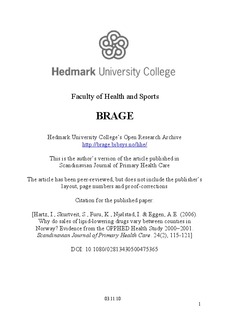| dc.contributor.author | Hartz, Ingeborg | |
| dc.contributor.author | Skurtveit, Svetlana | |
| dc.contributor.author | Furu, Kari | |
| dc.contributor.author | Njølstad, Inger | |
| dc.contributor.author | Eggen, Anne Elise | |
| dc.date.accessioned | 2010-11-03T09:49:10Z | |
| dc.date.available | 2010-11-03T09:49:10Z | |
| dc.date.issued | 2006 | |
| dc.identifier.citation | Hartz, I., Skurtveit, S., Furu, K., Njølstad, I. & Eggen, A.E. (2006). Why do sales of lipid-lowering drugs vary between counties in Norway? Evidence from the OPPHED Health Study 2000–2001. Scandinavian Journal of Primary Health Care. 24(2), 115-121 | en_US |
| dc.identifier.issn | 1502-7724 | |
| dc.identifier.uri | http://hdl.handle.net/11250/134190 | |
| dc.description | The original publication is available at: http://dx.doi.org/10.1080/02813430500475365 | en_US |
| dc.description.abstract | Objective. To study and compare plausible factors that might explain varying sales of lipid-lowering drugs (LLDs) in the two
neighbouring counties of Hedmark and Oppland in Norway, with a similar age distribution, socioeconomic structure, and
access to healthcare services. Design, setting, subjects. Cross-sectional population study comprising 10 598 attendants aged
40, 45, 60, and 75 years in the OPPHED Health Study, 2000 /2001 (attendance rate 61%). Main outcome
measure. Treatment eligibility (cardiovascular morbidity and risk score), treatment frequency in treatment-eligible
subgroups and treatment intensity in terms of achievement of total cholesterol (TC) goal. Results. Proportions eligible
for LLD treatment in Hedmark and Oppland were similar. There was no difference in prevalence of LLD use among
participants with cardiovascular disease or diabetes (secondary prevention subgroup). However, LLD use among men in the
primary prevention subgroup was higher in Hedmark compared with Oppland, 6.3% and 4.1%, respectively (pB/0.05).
The same tendency was seen among women. In both sexes, more LLD users in the primary prevention subgroup
achieved the TC goal in Hedmark compared with Oppland (pB/0.05). Conclusion and implications. The proportion of the
population eligible for LLD treatment in the two counties should imply similar treatment rates in both. Higher LLD
treatment frequency and intensity in the primary prevention subgroup in Hedmark are probably both contributing factors
that explain the higher sales of LLDs in Hedmark compared with Oppland. Feasible intervention thresholds for primary
prevention with concurrent reimbursement rules should be defined in guidelines to avoid unintentional variation in LLD
use in the future. | en_US |
| dc.language.iso | eng | en_US |
| dc.publisher | Scandinavian Journal of Primary Health Care | en_US |
| dc.subject | Lipid-lowering drugs | en_US |
| dc.subject | primary prevention | en_US |
| dc.subject | secondary prevention | en_US |
| dc.subject | ardiovascular disease | en_US |
| dc.subject | drug utilization | en_US |
| dc.subject | pharmacoepidemiology | en_US |
| dc.subject | farmakologi | en_US |
| dc.title | Why do sales of lipid-lowering drugs vary between counties in Norway? Evidence from the OPPHED Health Study 2000 /2001 | en_US |
| dc.type | Journal article | en_US |
| dc.type | Peer reviewed | en_US |
| dc.subject.nsi | VDP::Medical disciplines: 700::Basic medical, dental and veterinary science disciplines: 710::Pharmacognosy: 738 | en_US |
| dc.source.pagenumber | 115-121 | en_US |
| dc.identifier.doi | http://dx.doi.org/10.1080/02813430500475365 | |
